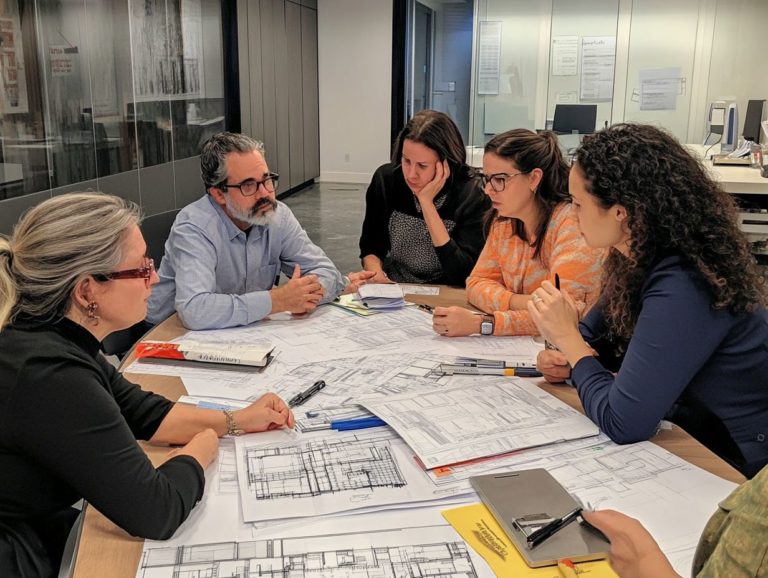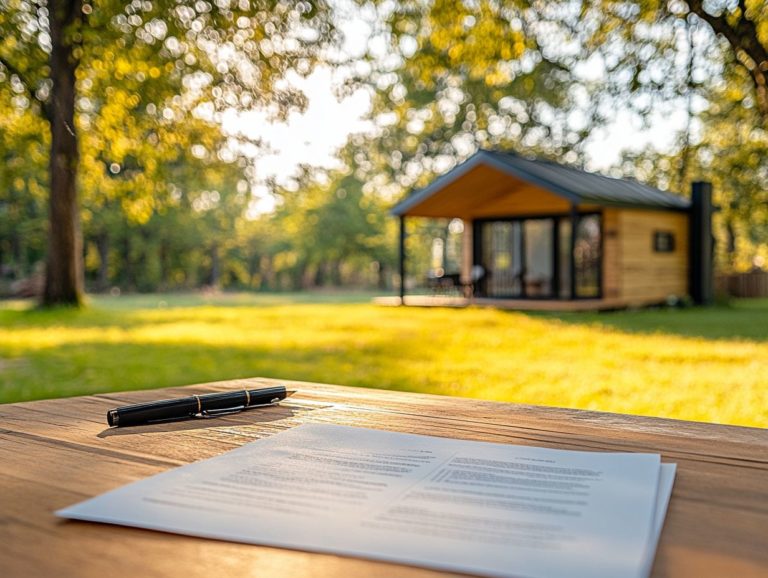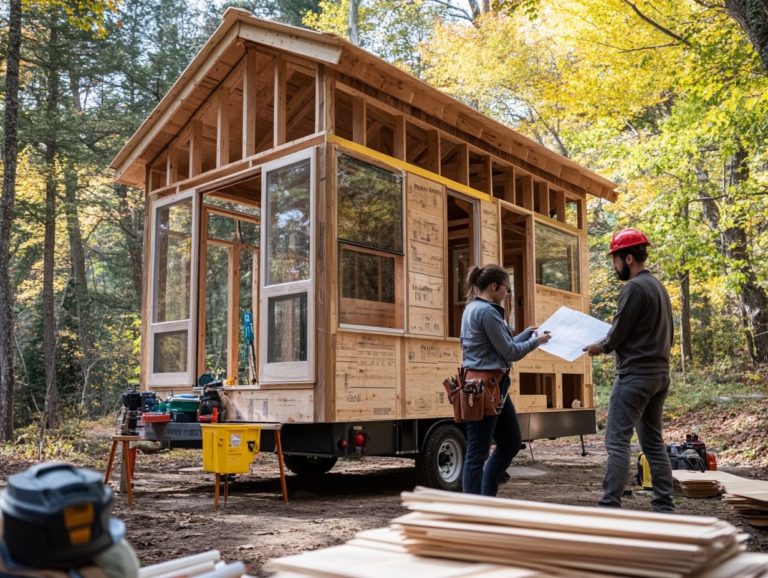Creating a Tiny House Lease: Legal Essentials
The tiny house movement has gained significant momentum in recent years. It offers a unique blend of minimalism and sustainable living, appealing to those looking to downsize.
Embarking on a tiny house lease brings its own set of challenges and considerations. This article will guide you through the intricacies of a tiny house lease. You will learn about important legal issues, zoning regulations, and how to draft a solid agreement that protects your interests.
You will also discover essential tips for successful leasing. This will help ensure a seamless and enjoyable living experience in your cozy new abode, whether it’s a foundation tiny house or a tiny home on wheels.
Are you ready to dive into the world of tiny house leasing? Let s embark on this journey together!
Contents [hide]
- Key Takeaways:
- What is a Tiny House Lease?
- Key Considerations for a Tiny House Lease
- Legal Essentials for a Tiny House Lease
- Additional Factors to Consider
- Tips for Creating a Successful Tiny House Lease
- Frequently Asked Questions
- What are the legal essentials to consider when creating a tiny house lease?
- Do I need a lawyer to create a tiny house lease?
- What should be included in the terms and conditions of a tiny house lease?
- What rights and responsibilities does a landlord have in a tiny house lease?
- Can I use a standard rental agreement for a tiny house lease?
- Are there any zoning or building code restrictions for tiny house leases?
Key Takeaways:

- A tiny house lease is a contract between the landlord and tenant for renting a tiny house on a designated property. It outlines the terms for living in a tiny house and protects the rights of both parties.
- Key considerations when creating a tiny house lease include ensuring the location and zoning regulations allow for a tiny house. Establish clear and fair lease terms to aid the success and legality of the tiny house lease.
- To create a legally sound tiny house lease, draft the agreement carefully. Incorporate relevant laws and regulations, including local guidelines. Consider factors like insurance, liability, and maintenance to protect both landlord and tenant.
What is a Tiny House Lease?
A tiny house lease is a specialized rental agreement tailored for tiny houses. These structures typically range from 100 to 400 square feet and include portable tiny houses and accessory dwelling units. These leases address the unique needs of tiny house owners and occupants.
As the appeal of tiny homes continues to rise, understanding the legal nuances of tiny house rentals is crucial for both renters and landlords.
Key Considerations for a Tiny House Lease
When you embark on a Tiny House Lease, consider several essential factors regarding location and zoning regulations. These aspects can significantly influence the legality and practicality of your tiny house living experience.
It’s crucial to pay attention to local zoning codes and the specific design of your tiny house. These elements will determine whether your lease is both feasible and compliant with state regulations.
Location and Zoning Regulations
Choosing the right location for your tiny house is essential. Zoning regulations can vary dramatically from one area to another, especially in local planning commissions that govern tiny house properties.
These regulations determine the permissible types of structures, their sizes, distances from property lines, and intended uses. For example, portable tiny houses may face strict limitations due to their mobile nature, while those built on permanent foundations could fall under residential building codes.
Local zoning codes also influence the density of tiny house communities. They determine how many units can develop on a specific parcel of land. Understanding these regulations is crucial to securing a suitable and compliant living arrangement.
Lease Terms and Conditions
The lease terms and conditions for tiny house rentals should be specifically tailored to capture the unique essence of tiny homes. This includes considerations for tiny home design and tiny house owners associations.
Essential elements such as minimum square footage requirements and factors related to potential Airbnb rentals which have become increasingly popular in the tiny house market must also be addressed.
Think about how exciting it is to customize your lease duration, which should align with the flexible lifestyles that tiny house owners often embrace. When it comes to rental prices, aim for a balance that is both competitive and reasonable, factoring in the amenities offered and the dynamics of the local housing market. Additionally, it’s crucial to be aware of the legal considerations for tiny house rentals to ensure compliance and protect your investment.
Rules about living in the house, particularly regarding pets or guests, are equally significant. Clear agreements ensure that everyone is on the same page and help prevent misunderstandings, especially regarding tiny house insurance and maintenance responsibilities. By crafting such thoughtful agreements, you not only uphold the minimalist philosophy of tiny living but also cultivate a harmonious relationship between property owners and renters. Additionally, it’s important to be aware of the legal aspects involved. For more information, check out navigating legal pitfalls in tiny house building.
Legal Essentials for a Tiny House Lease

Grasping the legal essentials for a Tiny House Lease is crucial for your compliance with various building codes (rules that ensure safety and quality in construction) and zoning regulations, particularly under the International Building Code (IBC) and International Residential Code (IRC).
Crafting a legally binding agreement that encompasses relevant laws such as plumbing codes and safety standards is essential for safeguarding the rights of both landlords and tenants, especially in tiny house communities. Understanding the legal implications of tiny house ownership ensures that this attention to detail not only protects your interests but also enhances the overall experience for everyone involved.
Drafting a Legally Binding Agreement
Drafting a legally binding agreement for your tiny house rental requires you to clearly outline terms that adhere to tiny house laws while addressing your specific needs. This ensures clarity and protection for everyone involved.
You also need to understand several essential components, such as the rental amount, payment schedule, and maintenance responsibilities. These factors are often influenced by state regulations and local zoning codes. It’s crucial to specify who will handle regular upkeep and repairs, as this plays a vital role in maintaining the condition of your tiny home and adhering to legal risks of building a tiny house standards.
The agreement should also encompass any local zoning regulations or limitations. Compliance with tiny house laws, including how to navigate tiny house legalities, can significantly affect how you draft the terms and the legal obligations each party must fulfill. This meticulous attention not only safeguards your rights but also paves the way for a harmonious living arrangement.
Incorporating Relevant Laws and Regulations
Incorporating relevant laws and regulations into your Tiny House Lease is crucial, particularly as they relate to tiny house-friendly policies. These guidelines help define the rights of both tenants and landlords while aligning with the principles of the Tiny House Movement, ensuring compliance with tiny house laws.
Understanding local zoning laws can greatly affect where you can place your tiny house and whether you can legally rent it out. Each municipality has its own set of requirements, such as minimum square footage, property setbacks, and utility connections. Additionally, it’s important to explore tiny house financing legal aspects, all of which you need to consider.
Complying with building codes keeps your tiny house safe, protecting both you and the property owner. It’s wise to reference these regulations in your rental agreements to clarify obligations and reduce the risk of potential legal disputes. For more details, consider reading about what to know about tiny house land leases, ultimately leading to a clearer understanding of the responsibilities that come with living in such unique accommodations.
Additional Factors to Consider
When drafting a Tiny House Lease, consider additional factors like insurance coverage and liability concerns. These elements can greatly influence the financial and legal security of both tiny house owners and their tenants.
Paying attention to these details ensures that everyone involved is protected and well-informed, especially regarding tiny house insurance and liability concerns.
Don t wait to secure your tiny house lease make sure you’re covered!
Tiny House Insurance and Liability
Insurance and liability are vital considerations in a Tiny House Lease. As a tiny house owner, it’s essential to secure adequate insurance, including tiny home insurance, to protect your property and minimize potential liabilities.
Given the unique nature of tiny homes, you’ll find a variety of insurance options available. These range from comprehensive coverage that protects both the structure and its contents to liability policies tailored to safeguard against accidents occurring on the property and potential legal disputes in tiny house rentals. It’s also important to consider understanding the legal status of tiny houses to ensure compliance with local regulations.
If you’re a tenant, don’t overlook renter’s insurance; it not only protects your personal belongings but also provides liability coverage if a guest is injured during their visit.
Incorporating specific insurance clauses into your rental agreements emphasizes the importance of these protections. It clarifies obligations regarding emergency exit points and safety measures, ensuring that the owner has the necessary coverage to defend against issues like theft, natural disasters, or accidents.
Such arrangements empower both owners and tenants to enter their lease with confidence, knowing they are well-protected against unforeseen circumstances.
Maintenance and Upkeep

In the realm of a Tiny House Lease, it’s essential that maintenance and upkeep responsibilities are clearly defined. This ensures you fully grasp your obligations for maintaining the tiny living space effectively.
Typically, landlords are responsible for keeping the house safe and sturdy. They ensure compliance with building codes and emergency exit points, addressing vital issues such as plumbing and electrical wiring and fixtures.
As the tenant, you are expected to maintain the interior s good condition. This includes routine cleaning, handling minor repairs, and possibly managing landscaping, depending on the property layout.
Given the unique design of tiny houses, often featuring compact spaces and unconventional systems, a more hands-on approach may be required on your part. You might find yourself managing appliances or utilities that demand a bit of extra attention.
By establishing mutual understanding of these maintenance responsibilities, you can cultivate a positive relationship with your landlord and help ensure the longevity of your tiny living experience.
Tips for Creating a Successful Tiny House Lease
Creating a great Tiny House Lease is all about clear communication and being open to change! These essential elements not only nurture a positive relationship between tiny house owners and renters but also guarantee mutual satisfaction.
Communication and Flexibility
Effective communication and flexibility are essential for a successful Tiny House Lease, empowering you and your tenant to address concerns and make necessary adjustments to your arrangements.
Establishing an open dialogue cultivates a relationship grounded in trust. This allows both parties to express their needs and expectations freely. Regular check-ins and transparent discussions about lease terms can effectively prevent misunderstandings that might escalate into disputes.
Being flexible during negotiations can lead to innovative solutions, such as adjusting rental prices or accommodating special requests. This collaborative approach enriches the living experience for your tenants and ensures that you, as a landlord, feel valued and understood, fostering a harmonious and lasting partnership.
Don’t wait! Review your lease today or consult a professional if you have any questions to ensure a smooth and successful rental experience.
Negotiation and Compromise
Negotiation and compromise are crucial elements of a successful Tiny House Lease. They allow tiny house owners and renters to craft agreements that cater to unique needs and circumstances.
These skills help improve lease terms, ensuring that both parties feel acknowledged and valued. For example, showing flexibility around monthly rental rates can bridge gaps, making it easier for renters to secure their dream space while enabling owners to maintain a steady income. Additionally, understanding the legal aspects of tiny house off-grid living can further enhance the renting experience.
Topics like utilities, maintenance responsibilities, and duration of stay can all be negotiated. A clear agreement on who handles repairs or how utilities are divided can lead to a more harmonious living arrangement, fostering a positive experience that enhances the sense of community within the tiny house movement. Being aware of the legalities of moving a tiny house is also crucial for ensuring compliance and peace of mind.
Frequently Asked Questions
What are the legal essentials to consider when creating a tiny house lease?

Key legal essentials to consider include the terms and conditions of the agreement, the rights and responsibilities of both the landlord and tenant, and compliance with local zoning and building codes.
Do I need a lawyer to create a tiny house lease?
While it’s not required to have a lawyer create a tiny house lease, it’s a smart move to get legal advice to ensure all necessary legal considerations are addressed in the lease agreement.
What should be included in the terms and conditions of a tiny house lease?
The terms and conditions should clearly outline:
- Duration of the lease
- Rent amount and payment schedule
- Security deposit requirements
- Rules for use of the tiny house and property
- Any other important details related to the lease agreement
What rights and responsibilities does a landlord have in a tiny house lease?
A landlord’s rights and responsibilities may include:
- Collecting rent
- Maintaining the property and ensuring compliance with building codes
- Providing necessary repairs or maintenance
These should be clearly outlined in the lease agreement.
Can I use a standard rental agreement for a tiny house lease?
No, a standard rental agreement may not cover all of the unique considerations and regulations involved in a tiny house lease. It’s crucial to customize the lease agreement specifically for a tiny house rental to ensure all legal essentials are included.
Are there any zoning or building code restrictions for tiny house leases?
Yes, it’s important to research and comply with local zoning and building codes when creating a tiny house lease. Some areas may have specific regulations for tiny houses, including size and location requirements.
Overall, taking these steps will help create a solid foundation for your tiny house lease. For further assistance, consider reaching out to a legal professional or rent a customized template.






